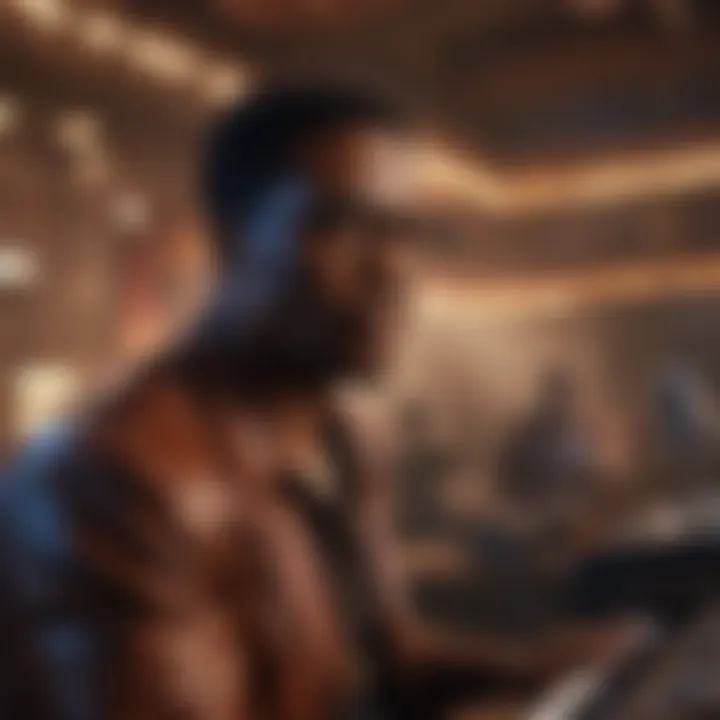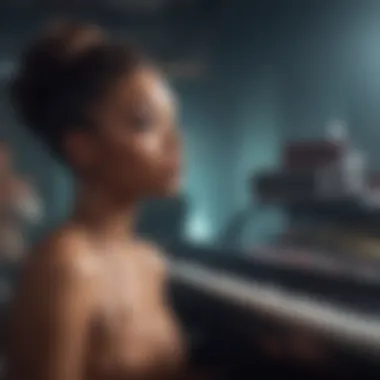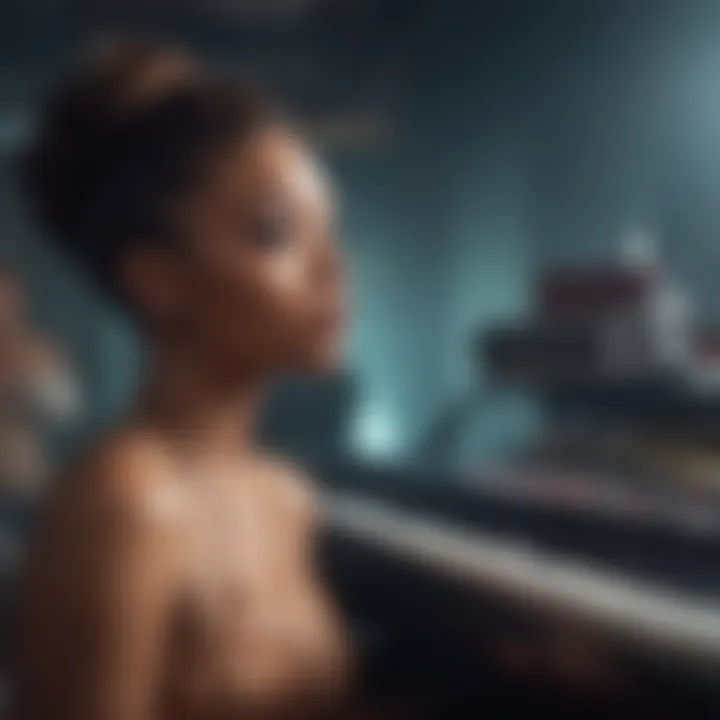The Essence of R&B: Exploring Its Cultural Depth


Intro
Rhythm and Blues (R&B) stands as a powerful cornerstone of modern music, weaving a rich tapestry that binds together the emotions, experiences, and soul of diverse communities. This genre bridges the past and present, breathing life into its roots while continuously evolving to reflect contemporary issues and joys. In the following sections, we will dissect the very essence of R&B, its beginnings, its defining traits, and its profound impact on popular culture. Whether you’re a casual listener drawn in by the smooth melodies or a dedicated aficionado with an ear for the intricate details, you’ll find something to deepen your appreciation of this dynamic genre.
Artist Profile
Biography and Background
To understand R&B, one can't overlook the monumental figures that have made significant contributions to the genre. Take for instance Aretha Franklin, widely hailed as the "Queen of Soul." Born in Memphis in 1942, Aretha's voice echoed through the confines of her father's church, where gospel melodies became the backdrop of her childhood. Her upbringing not only cultivated her vocal prowess but also infused her early sound with rich emotional depth. Franklin's career, spanning several decades, transformed her into a cultural icon whose influence remains palpable today. Artists across genres pay homage to her soul-stirring style, further embedding her legacy within the fabric of R&B.
Major Influences and Inspirations
Franklin is not an isolated incident, rather a mere representation of how closely intertwined R&B is with other musical styles. The genre draws inspiration from an array of sources like gospel, jazz, and even blues. The merging of these sounds has created a unique sonic landscape ripe with emotional resonance. For instance, Marvin Gaye's seminal work was profoundly shaped by the civil rights movements of the 1960s, weaving poignant social themes into love ballads. This kind of storytelling elevates R&B far beyond mere entertainment—it serves both as an emotional outlet and a reflection of societal dynamics.
Song Analysis
Theme and Lyrics Breakdown
R&B has a unique knack for portraying the intricacies of human emotion. Songs often explore themes of love, heartache, and self-discovery. Take a closer listen to "What's Going On" by Marvin Gaye; the lyrics delve into pressing social issues while maintaining a deeply personal touch. They explore the duality of joy and sorrow, a recurring motif that resonates with listeners. This ability to articulate complex feelings using relatable narratives transforms an ordinary song into an anthem of the times.
Instrumentation and Composition
Instrumentation in R&B often builds on classic elements—think smooth bass lines, soulful guitar riffs, and lush horns. The combination creates a soundscape that feels both warm and inviting. Notable tracks, like "Superstition" by Stevie Wonder, showcase the inventive use of keyboards and drum machines, pushing the boundaries of standard arrangements. Such elements work harmoniously, allowing vocalists to convey their stories with absolute clarity.
"Music is the universal language of mankind" - Henry Wadsworth Longfellow. This quote encapsulates the essence of how R&B emerges from varied backgrounds and influences, illustrating sentiments that cross cultural barriers.
In summary, R&B is a genre enriched by its historical roots and the passionate artistry of its pioneers. As we continue unraveling its many layers, we can appreciate not just the music, but also the messages, the struggles, and the triumphs that define this powerful form of artistic expression.
Defining R&B: A Genre Overview
Understanding the essence of Rhythm and Blues is akin to peeling back the layers of an onion—except instead of tears, one finds rich textures and intricate flavors. R&B serves as a vital bridge between various musical realms, fusing elements from jazz, blues, pop, and soul. This multifaceted approach gives the genre a unique quality that appeals to diverse audiences, making it an ever-relevant component of modern music culture.
In this exploration, we will delve into the crucial elements that outline the genre's identity, its historical significance, and its distinctive features. Appreciating R&B isn't merely about recognizing catchy hooks or smooth vocals; it’s about grasping the underlying emotions, cultural narratives, and inherent rhythms that form the backbone of the genre.
Historical Roots of Rhythm and Blues
R&B boasts a rich heritage steeped in history. Emerging in the mid-20th century, the genre crystallized the experiences and struggles of African Americans, serving both as an artistic expression and a social commentary. The term "Rhythm and Blues" was popularized in 1949, replacing the earlier designation "race music." This shift marked a step towards mainstream recognition, reflecting the hopes, sorrows, and aspirations of a people navigating a tumultuous landscape.
The blues, often seen as R&B’s ancestral roots, lay the groundwork with their storytelling and emotional depth. Simultaneously, influences from gospel music infused R&B with spiritual fervor and sonic richness, contributing to the genre's communal and uplifting essence. As R&B began taking shape, artists like Ray Charles and Aretha Franklin began breaking through racial barriers, paving the way for future generations to leave their mark.
Distinctive Sound Characteristics
The allure of R&B fundamentally lies in its distinctive sound characteristics, characterized by smooth melodies, rich harmonies, and an infectious rhythmic foundation. At its core, the genre often employs a touch of improvisation, drawing upon the jazz influence that permeates its DNA. When you listen to a classic R&B track, the interplay of instruments stands out—like a well-rehearsed dance, each movement complements the other.
Key characteristics of R&B sound include:
- Vocal Prowess: R&B is synonymous with strong, emotive singing. Artists often showcase their vocal agility and control, ranging from husky growls to ethereal falsettos.
- Groove and Rhythm: The beat is crucial. R&B songs typically feature a steady backbeat that encourages movement, creating an engaging experience for listeners.
- Instrumentation: From lush strings to subtle brass arrangements, the incorporation of diverse instruments adds depth to R&B tracks. This versatility can include the use of synths and samples in contemporary iterations, catering to changing musical landscapes.
R&B and its Evolution Through Decades
As the years rolled by, R&B gracefully adapted, reflecting societal changes and musical innovations. The 1950s ushered in Motown with its polished sound and universal themes, led by stars such as Stevie Wonder and The Supremes. Fast forward to the 1970s, and you encounter the fusion of soul and funk, with artists like Earth, Wind & Fire taking the stage. The melodies and rhythms evolved, but the spirit remained steadfast.
The 1980s and 1990s brought an influx of new influences, notably hip-hop, which further reshaped R&B. Artists began to experiment with beats and lyrical content. Through the sultry sounds of Mary J. Blige and the smooth styles of R. Kelly, R&B continued to thrive while embracing change.
In the 2000s and beyond, the genre transitioned into a new era characterized by a blending of styles. Contemporary names like Beyoncé and Frank Ocean are testament to how R&B has morphed—infusing elements of pop, hip-hop, and even electronic music while retaining its core emotional and rhythmic foundations.
With each passing decade, R&B has not only survived but flourished, marking its significance as a living, breathing entity in the music industry.
"R&B is not just a genre; it's a movement that resonates with the soul."
In summary, defining R&B reveals a tapestry woven from historical contexts and sound characteristics that have evolved and adapted over the years. It’s not only a listening experience but also a cultural commentary, sprouting from the rich soil of emotional and societal narratives.
Iconic R&B Artists and Their Contributions
The essence of Rhythm and Blues (R&B) lies significantly in the artists who have shaped its sound. Well before trends wax and wane, these trailblazers laid the groundwork for R&B, blending genres and breaking barriers. The impact of these artists resonates through their unique styles and stories, earning them a cornerstone place in music history.
Trailblazers of the Genre
Ray Charles
Ray Charles is often hailed as the "Father of Soul", merging gospel, blues, and R&B into something utterly groundbreaking. One specific aspect that stands out is his ability to convey deep emotion through his vocals, which set a benchmark for future artists. Charles’ signature style—his impassioned growls, heartfelt cries, and playful melodies—made his music relatable and engaging. This capacity for emotional connection plays a crucial role in the ongoing dialogue of R&B's development.
His blend of gospel with secular themes opened doors for countless musicians in the genre. Charles' unique feature lies in his piano skills paired with his soul-stirring voice, an advantage that allows him to move seamlessly between joyous tunes and heart-wrenching ballads. However, his crossover success, while monumental, also brings up questions of authenticity in the genres he fused. Still, it's undeniable that Ray Charles’ influence paved the way for countless artists who followed, shaping the genre immensely.
Aretha Franklin
When discussing R&B, Aretha Franklin’s name rings louder than a church bell on Sunday morning. Known as the "Queen of Soul", her contribution to the genre is monumental; Franklin elevated the status of women in music, using her powerful voice to command the stage. Her distinct characteristic is the ability to blend raw emotion with technical proficiency, notably seen in her iconic song "Respect". This track not only became an anthem for the civil rights and feminist movements but also illustrated the power of R&B as a medium for social commentary.
Her unique feature was her capability to intertwine different genres, notably gospel and blues, creating a sound that was both spiritual and earthly. Although some critics argue her style may not fit traditional definitions of R&B, her influence is indisputable; her work continues to inspire generations, resonating deeply with themes of love and resilience in the face of adversity.
James Brown
When one talks about R&B, no conversation would be complete without mentioning James Brown—the self-proclaimed "Godfather of Soul." His explosive performances and dynamic stage presence transformed the very fabric of live music. An essential aspect of Brown’s contribution to R&B is his rhythm-centric approach, forever focusing on groove as a driving force. This is captured in songs like "Papa's Got a Brand New Bag", which showcases his ability to create hypnotic musical phrases that keep listeners engaged.
Brown's energy and unique phrasing in his singing set him apart, his performances widely appreciated for their fervor and spontaneity. The downside is that his style sometimes leaned more toward spectacle than subtlety, raising critiques regarding the depth of lyrical content in some cases. However, it is precisely this showmanship that made him a pivotal figure in shaping live performances within the genre, merging R&B with the artistry of the stage.
Contemporary Influences
Usher
Shifting gears toward modernity, Usher stands out as a defining figure of contemporary R&B. He is credited for not only maintaining but evolving the genre, skillfully fusing it with pop and hip-hop elements. A marked aspect of Usher’s career is his smooth vocal delivery combined with intricate dance routines. This synthesis has brought a new level of entertainment to the genre, capturing younger audiences while engaging older fans.
His uniqueness lies in his mastery of storytelling through music, particularly in tracks like "Confessions Part II," where he navigates love and betrayal with astonishing authenticity. The downside can sometimes be a reliance on pop structures, which some purists may view as diluting true R&B. However, his efforts to innovate while staying rooted in R&B traditions enhance the genre’s reach and visibility.
Rihanna
Rihanna’s impact on R&B transcends typical genre boundaries, continuously evolving in both sound and image. Known for her unmistakable voice, she has contributed significantly to R&B's current landscape with tracks like "We Found Love," which harness pop sensibilities while remaining true to the soulful undertones of her earlier work. The key characteristic of Rihanna’s music is its ability to blend, creating a sound that is not easily categorized.
Her unique approach to collaboration—working with a diverse array of producers and artists—has helped her maintain relevance in a fast-changing music environment. Critics might say that some of her success hinges on her commercial appeal, occasionally overshadowing her R&B roots. Yet, her voice still resonates powerfully within the genre, proving its adaptability and resilience.
Frank Ocean
Last but certainly not the least, Frank Ocean has emerged as a modern lyrical powerhouse in R&B, known for his introspective and sometimes abstract storytelling. Ocean's specific aspect is his unique approach to narrative within music. He uses vivid imagery and personal themes to engage listeners, particularly evident in albums like "Blonde." In a way, he reshapes R&B by weaving in elements of hip-hop and alternative styles, broadening the genre's audience.
His distinct quality is his refusal to adhere to conventional song structures, often crafting tracks that meander and evolve. This complexity can challenge some listeners, but it brings a refreshing depth to the genre. The blend of these influences contributes to both his poetic lyrics and inventive soundscapes, solidifying his significance as a contemporary R&B artist.
The journey of R&B is inherently tied to its artists, who pave the way for new sounds and expressions. Through their innovation and authenticity, they continually redefine what it means to be part of this vibrant genre.
Thematic Exploration in R&B Lyrics
The thematic exploration of lyrics within R&B is not just a reflection of personal sentiments; it's a cultural touchstone that resonates with a multitude of listeners. R&B lyrics dive into the depths of human experience, often taking center stage in songs. They tackle a wide array of subjects like love, social justice, and personal identity, which makes the genre appealing and relatable. This engagement with lyrical depth allows for listeners to connect on a more profound level, paving the way for both emotional and intellectual appreciation of the music.
Love and Relationships
When it comes to love, R&B offers a rich tapestry of emotions. The genre’s lyrical narrative often encapsulates both the highs of infatuation and the lows of heartbreak. Take for instance the classic song "Ain't No Mountain High Enough" by Marvin Gaye and Tammi Terrell, which speaks to unwavering devotion. It reveals how love can conquer all obstacles, expressing sentiments that are both timeless and universal.
Conversely, tracks like "End of the Road" by Boyz II Men vividly portray the anguish of lost love, making listeners feel the weight of betrayal and heartache without skipping a beat. R&B has an emotional palette that captures complexities that many other genres might gloss over. It’s not merely about romance; it’s also about the struggle, the longing, and the journey of human connection.
"R&B lyrics are like a mirror reflecting the joys and trials of love, capturing emotions that transcend cultural barriers."
Identity and Self-Expression
R&B serves as a platform for artists to express their individual identities and cultural backgrounds. In a world where identity can be fluid, R&B artists dive into personal narratives that reveal their struggles and triumphs. For instance, artists like Frank Ocean push boundaries with their lyrics, exploring themes of sexuality, race, and self-acceptance. In songs such as "Call Me By Your Name," he confronts societal norms and personal truths, providing a voice to those who feel marginalized or unheard.
This emphasis on self-expression contributes significantly to the genre's allure, allowing listeners to see themselves reflected in the music. The duality of vulnerability and strength found in these lyrics resonates deeply, often leading to broader discussions about identity within society. It reminds the audience that their unique experiences are valid, fostering a sense of belonging and acceptance.
Social Issues and Commentary
R&B has a historical foundation of addressing social issues, and this aspect remains vital in its lyrical content today. Songs like "What's Going On" by Marvin Gaye had a profound impact, as they tackled the pressing social issues of their time, including war, civil rights, and environmental concerns. This tradition continues with modern artists who weave social commentary into their work, shining light on racial inequality, police brutality, and more.
For example, songs like "This Is America" by Childish Gambino wield their art as a mirror to society, provoking thought and encouraging dialogue around critically important topics. By integrating social themes into their music, R&B artists foster awareness and stimulate conversations that are essential for societal progress. Performing in the realm of personal experience, they effectively elevate individual stories to a collective narrative that advocates for change.
Influential R&B Albums to Explore
When it comes to understanding the vast universe of Rhythm and Blues, the albums that have shaped its landscape are like beacons illuminating the path. They inject life into the genre, offering not just catchy melodies but profound messages. Delving into these influential albums allows one to appreciate how R&B has evolved, woven itself into various cultural fabrics, and expressed emotions that resonate across generations. Each album tells a unique story that reflects societal shifts, personal struggles, and triumphs.
Landmark Releases
What's Going On - Marvin Gaye
Marvin Gaye's What's Going On isn't just an album; it's a sonic experience that turned the heads of both listeners and critics alike. Released in 1971 during a time of social upheaval, its themes of love, peace, and social justice are as relevant today as they were then. The standout characteristic of this album is its cohesive narrative—each track seamlessly transitions into the next, creating a story that feels both intimate and grand.


One key feature is the use of lush instrumentation, blending soul, jazz, and orchestral sounds that enhance Gaye's silky vocals. This album is a powerful choice because it etched the idea of R&B as not just a genre of entertainment but a medium for sociopolitical commentary. A duality exists here: while it captivates with its sound, it also challenges listeners to grapple with the hard truths of their surroundings.
Songs in the Key of Life - Stevie Wonder
Stevie Wonder’s Songs in the Key of Life is nothing short of a masterpiece, released in 1976. This album is revered not only for its rich musical tapestry but also for Wonder's ability to touch on diverse themes, from love to self-reflection and social awareness. Songs in the Key of Life showcases Wonder's versatility—from upbeat tracks that compel one to dance to poignant ballads that tug at the heartstrings.
What makes this album stand out is the meticulous production and Wonder's incorporation of various styles like funk, jazz, and pop. It's a beneficial pick because it reflects R&B's ability to transcend genres and appeal to a wide array of music lovers. The unique aspect here is the interlude of spoken word that adds a personal touch, inviting listeners into his world while showcasing the cultural kaleidoscope of the time.
Voodoo - 'Angelo
D'Angelo’s Voodoo, released in 2000, marked a return to a more organic sound within the R&B landscape. This album is celebrated for its innovative approach, steering clear of the heavily produced sounds prevalent at the time. Instead, D'Angelo opts for a raw, gritty aesthetic that places emphasis on instrumental performance and vocal depth. The key characteristic of Voodoo is its soulful yet seductive melodies, enveloped in rich grooves and rhythm.
The uniqueness of this album lies in D'Angelo's immersive songwriting, which combines personal tales with broader themes, echoing his struggles and triumphs. If there’s a disadvantage, it might be the high bar it sets for other contemporary R&B artists, but that's also a testament to its significance. Voodoo serves as a prime example of how R&B can evolve while remaining grounded in its rich history.
Contemporary Must-Listen Albums
Channel Orange - Frank Ocean
Frank Ocean's Channel Orange, released in 2012, pushed the boundaries of R&B. This album stands out for its unconventional storytelling and blending of genres, making it a pivotal entry in the R&B pantheon. Ocean’s lyrical vulnerability paired with innovative beats creates a talking point regarding intimacy in music.
The album's unique feature is its seamless transitions between tracks, almost like a musical journey, which encourages deep listening rather than casual play. This makes it a popular choice in this article, as it exemplifies the new era of R&B, where genre-fluidity becomes the norm rather than the exception.
Anti - Rihanna
Rihanna’s Anti illustrates her evolution as an artist, released in 2016. This album is key for its bold departure from typical commercial sounds, embracing a more personal and experimental approach. The distinct characteristic of Anti is Rihanna's emphasis on authenticity, which resonates through each song’s themes of empowerment and self-discovery.
The standout aspect is the effortless integration of various music styles, from reggae to soul. This album is a beneficial inclusion here because it reflects the current trends in R&B, showcasing how even mainstream artists are navigating authenticity in a market often swayed by commercial interests.
Blonde - Frank Ocean
Following up on his groundbreaking work, Frank Ocean’s Blonde is an embodiment of minimalism and deep introspection, released in 2016. It contrasts the often upbeat nature of R&B, instead providing a haunting soundscape that captivates listeners. The central aspect of Blonde is its experimental approach, which blends various sounds, creating a tapestry rich in emotion and storytelling.
This album is a crucial choice because it explores themes of love, identity, and existentialism in ways that feel both personal and universal. Frank Ocean’s decision to veer away from traditional song structures can be viewed as a double-edged sword; while it challenges the norms, it may leave some listeners yearning for more familiar formats. Nonetheless, Blonde represents a significant shift in modern R&B, challenging artists to push creative boundaries.
In looking at these albums, one can see how R&B threads through the fabric of contemporary music, continuously adapting while maintaining its core essence.
The Impact of R&B on Other Genres
Rhythm and Blues, over the years, has left an indelible mark on numerous musical genres, shaping their evolution through a myriad of influences. The impact of R&B is multifaceted; it doesn’t just dwell in its own space but seeps into and enriches the soil of other styles. Understanding the threads that weave R&B into the fabric of contemporary music offers insights into its significance. R&B's rhythmic complexity, emotional depth, and vocal delivery have always served as inspirations for artists across the musical spectrum.
The Synthesis with Hip-Hop
A notable fusion emerges in the collaboration between R&B and hip-hop. Artists like Usher and Drake have mastered this synthesis, blending soulful melodies with rap's storytelling elements. This partnership often results in tracks that resonate well on the charts and within communities. For example, Drake’s track "Hotline Bling" stands out with its catchy R&B-infused hook while showcasing hip-hop rhythms.
- Cross-Genre Collaborations: The collaboration between hip-hop and R&B stars has led to many chart-topping hits, significantly enriching both genres.
- Production Values: Producers like Timbaland have been key in merging these styles, utilizing beats that highlight both genres’ strengths, creating something fresh yet familiar.
This blending features not only aesthetic harmony but also cultural significance, creating a bridge that allows diverse audiences to connect through shared themes of love, hardship, and triumph.
Influence on Pop Music
R&B's influence on pop cannot be overstated. Chart-topping pop artists often draw from R&B's deep well. Artists such as Beyoncé and Justin Timberlake have infused their pop sound with R&B vibes, pushing the envelope for what is considered mainstream music. In fact, one can hear R&B's shadow in the arrangements, vocal ad-libs, and lyrical themes of today's pop music.
- Melodic Elements: Straightforward hooks in songs are derived from R&B’s smooth melodies, making pop tracks catchy and listenable.
- Emotional Connection: R&B’s emphasis on personal narratives allows pop music to explore relatable themes which engage a wider audience.
The expert blend of groove, harmony, and modern production makes R&B's influence on pop an unmissable aspect in the growth of the popular music landscape.
Integrating Elements of Soul and Funk
The roots of R&B are so intertwined with soul and funk that it’s hard to delineate where one ends and the other begins. These genres share a rhythmic backbone and emotional intensity that collectively showcase the voices of their eras. R&B has drawn from the dynamic grooves of funk and the emotional expression of soul, resulting in a powerful amalgamation.
- Rhythmic Foundations: One can hear the syncopated bass lines and electric guitar riffs reminiscent of funk in many R&B tracks. These elements provide the pulse needed to get audiences moving.
- Emotive Lyrics: The deep emotionality found in soul music shapes the storytelling aspect of R&B. Artists channel their experiences to create deeply resonant messages that touch listeners' hearts.
The interplay among these genres not only diversifies R&B but also enhances the overall sound of modern music.
"R&B's ability to evolve by borrowing from soul and funk reflects its core purpose: to express human experiences and emotions across generations."
Through this multi-genre examination, it becomes evident that R&B is not a static genre. Its influence has both defined and transformed the music landscape, ensuring its contemporary relevance as genres continue to intermingle.
R&B in the Age of Digital Music
As we stride into the 21st century, digital music has transformed the R&B scene significantly. This shift opens doors to both challenges and opportunities that reshape how artists create, distribute, and promote their music. The importance of understanding these dynamics cannot be overstated, as they play a crucial role in defining the future of Rhythm and Blues.


Streaming Services and Accessibility
Streaming platforms have become the lifeblood of the modern music industry. Whether it's Spotify, Apple Music, or Tidal, these services have made R&B more accessible than ever before. Listeners can explore vast catalogs of music, discovering both the classics and the latest hits with ease.
- Global Reach: Artists can now reach listeners worldwide without the barrier of traditional radio play.
- Curated Playlists: With playlists dedicated to different moods or themes, like "Chill R&B" or "Classic Love Songs," listeners can engage with the genre in tailored ways.
- Data Insights: Streaming services provide detailed analytics to artists about their audience, allowing them to tailor music and marketing strategies specific to their fan base.
The implications of such accessibility encourage a broader appreciation of R&B, turning casual listeners into devoted fans overnight.
The Role of Social Media in Promotion
Social media platforms like Facebook, Instagram, and Twitter have revolutionized how artists communicate with their fanbase. Unlike earlier times, when publicists handled everything, artists can now take the reins of their promotional strategies.
- Direct Engagement: Platforms allow artists to connect directly with fans, fostering a sense of community; anecdotes and snippets of personal life create a deeper bond.
- Viral Challenges: Trends like TikTok challenges help to propel songs to viral status, often launching new singles or reviving old classics on the charts.
- Content Sharing: Artists easily share rehearsal footage, behind-the-scenes clips, or even live performances, making their work feel more relatable and accessible.
These methods prove that social media is not just a tool; it's an essential part of the R&B landscape that can propel an artist's career to new heights.
Emerging Independent Artists
The digital age has also birthed a wave of independent artists who are redefining the R&B genre. With platforms such as Bandcamp and SoundCloud, aspiring musicians can bypass traditional labels, releasing their music on their own terms.
- Authentic Voices: These artists often bring unique experiences and perspectives that reflect their diverse backgrounds, enriching the genre.
- Creative Freedom: Without the restrictions of a record label, independent artists can experiment with sounds and lyrical themes often sidelined in mainstream music.
- Community Building: Many independent artists cultivate loyal fanbases through crowdfunding and direct sales, enabling them to create music that resonates on a personal level.
"The most significant change in the music industry today is that artists can afford to be unique, and that uniqueness is what will sustain them in the long run."
As we navigate through this thriving, digital landscape, it’s crucial for music lovers and aspiring musicians alike to recognize and adapt to these trends, enriching R&B's vibrant legacy.
Cultural Significance of R&B
Rhythm and Blues, often abbreviated as R&B, transcends mere entertainment; it serves as a potent cultural artifact. The genre not only showcases the artistic flair of its artists but also encapsulates societal narratives, making it critically important. It has long been a voice for the marginalized, echoing struggles, triumphs, and historical contexts through its lyrics and melodies. This uniqueness in sound and story positions R&B as more than just music; it’s a way of life that reflects the emotional and social fabric of society itself.
R&B as a Reflection of Society
R&B stands out as a vivid mirror to the cultural landscape, capturing the zeitgeist of various eras. From its roots in the African American community to its current global appeal, the genre poignantly reflects societal changes and challenges. The lyrical content often addresses issues like love, pain, and social justice. For instance, Marvin Gaye’s What’s Going On taps into the unrest and turmoil of the 1960s, a composition that resonates as much today as it did then.
The intertwined nature of R&B and societal issues can be related to key historical events that shaped music and culture. For example, during the civil rights movement, artists like Aretha Franklin harnessed the emotional weight of R&B to inspire hope and strength. Thus, each note and lyric tells a story that isn’t merely personal but broadly societal, reflecting the winds of change and sentiment in the world around us.
"Music can change the world because it can change people." - Bono
The Genre's Role in Social Movements
R&B has played a crucial role in various social movements, acting as a rallying cry for change and awareness. The genre’s ability to resonate with societal injustice has fueled impetus behind movements focused on civil rights, gender equality, and other social issues. It’s not mere coincidence that many of the movements correlate with songs that have become anthems over the decades, like Sam Cooke’s A Change Is Gonna Come, which encapsulated the hopes and dreams of many during the civil rights era.
R&B has also fostered unity among diverse groups, breaking barriers with its emotionally charged melodies. Artists have used their platforms to spread messages of hope, resilience, and activism. For example, Beyoncé's Formation combines elements of empowerment with discussions around race and identity, marking a significant point in contemporary social commentary. The ability of R&B to adapt and remain relevant in the face of new challenges showcases its importance in ongoing social conversations.
Celebrating Diversity in R&B
One of the defining features of R&B is its celebration of diversity, both in musical influence and in the backgrounds of its artists. The genre is a fusion of various styles – from jazz, gospel, and blues to hip-hop and electronic music. This eclectic amalgamation mirrors the rich tapestry of cultures within the genre’s community. Artists of different ethnicities, gender identities, and sexual orientations contribute to the industry, each lending a unique voice to the evolving narrative.
This diversity not only enhances the sound but also challenges societal norms and stereotypes. For instance, Frank Ocean’s candid discussions about sexuality in his works invite listeners to embrace authenticity and vulnerability. Moreover, the genre often highlights experiences that resonate across cultures, connecting people from various walks of life and fostering a sense of inclusivity.
Future Trends in R&B
As the world of music continues to morph and evolve, the Rhythm and Blues genre is finding itself at a crossroads. With its rich roots and the innovative spirit of its artists, R&B is adapting to new influences while still honoring its classic sounds. This section examines the future trends within this dynamic genre, shedding light on the processes that keep it alive and significant in contemporary culture.
The Rise of Genre Blending
The artistic landscape of music is shifting dramatically. R&B, known for its deep emotional connection and melodic beauty, is not standing idly by. One prominent trend is the rise of genre blending, where artists are immersing themselves in multiple styles to create something entirely their own.
Genre blending not only reflects the diversity of musical tastes but also speaks to a society where boundaries are increasingly blurred.
For example, artists like Khalid fuse elements of pop and hip-hop into their R&B music, creating tracks that resonate with a wider audience. Similarly, SZA incorporates alternative influences, crafting a unique listening experience. These artists, along with others, break the traditional molds of R&B, paving the way for a multilayered sound that is both fresh and familiar. Furthermore, the accessibility of such eclectic musical inspirations is driving many aspiring musicians to experiment fearlessly.
Innovations in Production Techniques
In the age of technology, production techniques play a pivotal role in shaping the sound of R&B. With the advancement of music production software and hardware, artists are now able to create intricate soundscapes from their home studios. This democratization of music production means that more voices can enter the R&B arena.
- Home Studios: Musicians no longer need big budgets to create high-quality recordings. Affordable equipment and software, like Logic Pro or Ableton Live, empower independent artists to craft their projects.
- Virtual Collaborations: Social media platforms enable remote collaboration, allowing artists from different corners of the globe to work together seamlessly.
Take for instance the groundbreaking work of producers like Timbaland, who redefine what R&B can sound like through innovative beat-making and layering techniques. The integration of electronic beats with soulful melodies might just be the future sound of R&B.
Audience Engagement in a Digital Era
With the proliferation of social media and streaming platforms, engaging audiences has reached new heights. R&B artists are leveraging these technologies not just for distribution but also for connection and feedback.
- Social Media: Platforms like Instagram and TikTok are key for artists to promote their work, interact with fans, and even generate viral moments. For instance, snippets of songs that catch onto trends can lead to significant boosts in popularity.
- Live Streaming: Digital concerts have become a norm, offering artists the chance to connect with fans in real-time, regardless of geographical constraints. This is especially significant within the R&B community, as live performances have historically been a cornerstone of the genre.
As the interaction between artist and fan grows more immediate, R&B as a genre becomes more relevant and personal. Artists are not just musicians anymore; they're brands, storytellers, and community leaders, shaping the narrative of the genre for years to come.







